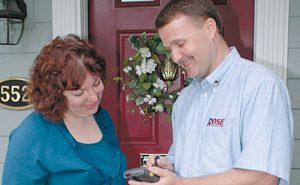
Pertinent photos can be shared with the customer at the account, and/or incorporated into the final service report.
Photo: Gene White, BCE
Last month at the North Central Branch of the Entomological Society of America event, I had the privilege of preparing “What’s in a Picture,” a presentation detailing the history of photography, its present and future, and how it relates to professional pest management.
Photography can be a useful tool in the pest management technician’s toolbox because it:
- Aids in a pre-assessment of potential account needs and important topics, such as safety risk assessments.
- Visually reinforces to the client what conducive conditions need correction before the next visit.
- Records the services provided.
- Documents additional service findings, such as structural pest damage and new service needs.
- Shows successful account corrections.
- Proves finished contractual obligations.
Before your techs snap their first shot at an account, though, they must get permission from the customer. While most clients are happy to do whatever it takes to get their pest problem resolved, others might have an issue with privacy or some other reason for not wanting their home or workplace photographed. It is important to respect their wishes.
The best way to confirm permission is to have a “check box” option on your service agreement, with verbiage along the lines of “I give XYZ Pest Solutions permission to photographically document the situation to help determine the best strategy for control.”
Once you get buy-in from the customer, having your technicians document an account with a digital camera — or even a smartphone — can accomplish three things on the spot:
- Inform clients of current pest-conducive situations.
- Create a one-on-one interface between client and technician.
- Proactively indicate future structural or environmental challenges.
Photographs also can protect your company long-term. For example, photo documentation of the site conditions prior to service can be admissible in court, and could be the lynchpin of your defense against misapplication. Digital cameras automatically encode such data as place and time a photo was taken, so you can prove work was done on a specific date. Take care to document any structural damage that later could be incorrectly blamed on your visit, as well as any instances of non-compliance — you asked them to bag all belongings, yet they left certain objects in the room, for example.
In next month’s Mobile PMP column, we’ll continue to explore how photography affects the pest management industry: In particular, how you can help well-intentioned clients — and potential clients — who send poor-quality images of what look to be dark specks, demanding identification of the pest species.
The label is the “law”
Although not quite as intense as following a pesticide label, providing written context for a documentation image is a critical step not to be skipped. Don’t let your techs get away with an “I’ll do it later,” because when they do go back to the photo after other accounts and tasks have transpired, the reason for taking the image may no longer be clear to them. The U.S. National Parks Service has a downloadable PDF that offers great advice. While it was written for those applying for structural preservation grants, its photo labeling tips include:
- Include building name and/or address.
- Specify view (“north side, from first floor,” etc.).
- Include description (“plaster damage in dining room, north wall,” etc.).
- Photographs keyed to a plan(s) of the building and site facilitate review of the proposed work.
Gene White is Rentokil Steritech’s technical director. You can reach him at gwhite@rentokil.com.
Leave A Comment